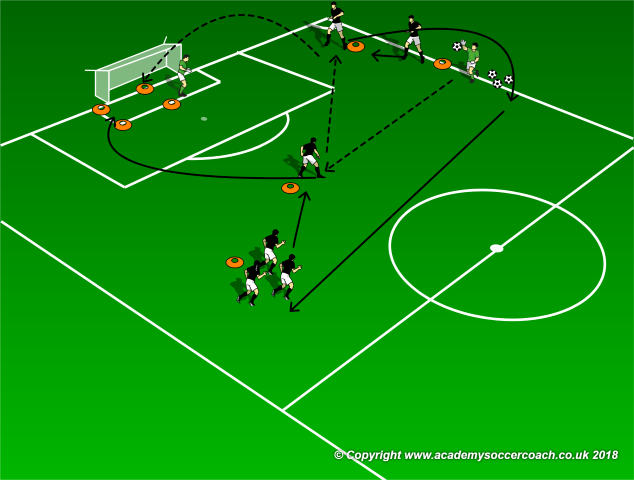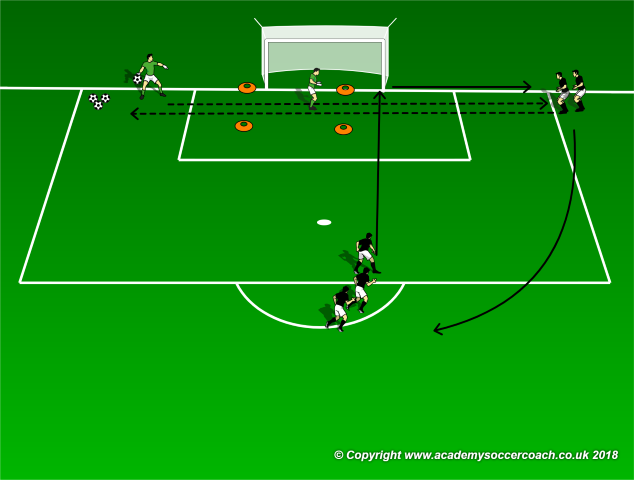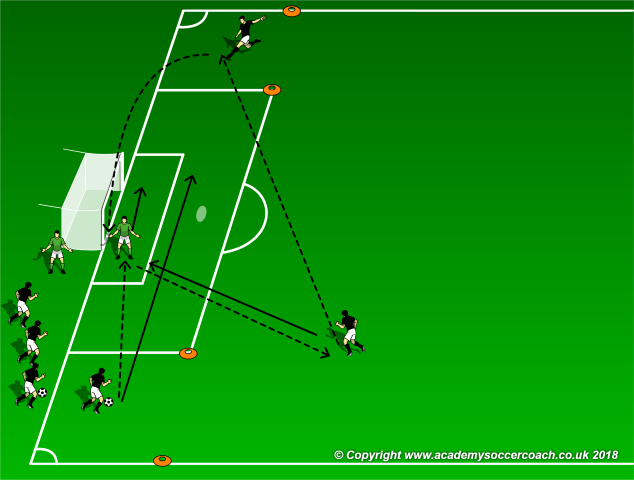By Mike Smith -
Many players and coaches think the idea of winning a ball only means coming away clean with it, and in most respects I would agree. For keepers however, the idea of winning the ball is different and this difference is especially important when facing crosses. Denying shots is a win for a keeper, even if that means giving up a corner. I often see keepers get fixated on catching crosses, which is wonderful, but almost always see these same keepers get burnt when they should have just tapped the cross up over the bar or punched it high and away. As with any position, the idea is for the player, in this case the keeper, to make the right play at the right time. I have had success with this drill progression to help my keepers deal with the varying types of crosses in the right way.
Set Up

The main focus in the above diagram is the cone box behind the keeper, which basically cuts the keeper box in half. The keeper must play in the ball side part of the box with the intention of making the right read – catch the cross clean, parry over the bar or punch out wide. As shown, an additional keeper starts play ( and works on their distribution ) by sending the ball across to an attacker who passes out for the cross. Make sure the players hitting the crosses are skilled enough to hit varying types – lobs, driven high balls, out swingers, ( in swingers from here if you have a good left footer ), etc… with the goal being to put the crosses in a spot where the keeper can make a play. The central attacker can run up to finish anything that gets past the keeper but the finish must come from inside the cone box. The distance the initial service is made from can be adjusted to make sure the keeper is getting a play on the ball and can be moved out as far as an actual corner kick as an advancement.
Progression

As shown above, move the cone box a bit to cover about three quarters of the goal. The keeper must make saves or clearances from the cone box. The crosses here will be more driven with the initial service coming from an additional keeper as shown. An added element, ( which can be an option or progression ) is to send an attack at speed to the near post. This attacker may win the ball for a finish but the idea is simply to expose the keeper to players coming in which may shield their line to or vision of the ball for a moment. The serving players should vary the types of crosses again here, to include everything from higher driven balls to balls on the ground ( which hopefully the keeper can smother.)

Finally, put the keepers in a situation where they must make the right read, and give the attackers discretion as to which type of service is coming in. Cone off the wide areas outside the penalty box ( as shown ) and have groups of 3 attackers move to create a service and finishing attempt. Play starts with one wide attacker sending the ball to the keeper, who plays it out to the top of the box for another attacker to send across to the other coned area. Here, a third attacker sends in a cross. The attacker who initially started the play makes a near post run, and the attacker who sends the ball out wide makes a far post run. The keeper should shift across the face of the goal as the ball is played from one side to another. Groups of 3 attackers and additional keepers should rotate in.
Coaching Points
This whole session is about winning by denying shots and making the right read given the situation. The coach should constantly help and encourage the keeper with directives – catch it, parry it, punch it, smother it, etc…. and focus on the particular area your keeper has trouble with.
By Mike Smith
Currently the Head Coach for University Heights Academy Boys Soccer in Hopkinsville, KY , Mike is in his 14th year as a high school head coach with 23 years coaching experience overall and 34 year as a student and fan of the game. He holds a USSF D License.


